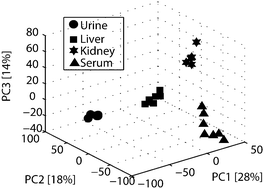The pig is a single-stomached omnivorous mammal and is an important model of human disease and nutrition. As such, it is necessary to establish a metabolic framework from which pathology-based variation can be compared. Here, a combination of one and two-dimensional 1H and 13C nuclear magnetic resonance spectroscopy (NMR) and high-resolution magic angle spinning (HR-MAS) NMR was used to provide a systems overview of porcine metabolism via characterisation of the urine, serum, liver and kidney metabolomes. The metabolites observed in each of these biological compartments were found to be qualitatively comparable to the metabolic signature of the same biological matrices in humans and rodents. The data were modelled using a combination of principal components analysis and Venn diagram mapping. Urine represented the most metabolically distinct biological compartment studied, with a relatively greater number of NMR detectable metabolites present, many of which are implicated in gut-microbial co-metabolic processes. The major inter-species differences observed were in the phase II conjugation of extra-genomic metabolites; the pig was observed to conjugate p-cresol, a gut microbial metabolite of tyrosine, with glucuronide rather than sulfate as seen in man. These observations are important to note when considering the translatability of experimental data derived from porcine models.

You have access to this article
 Please wait while we load your content...
Something went wrong. Try again?
Please wait while we load your content...
Something went wrong. Try again?


 Please wait while we load your content...
Please wait while we load your content...